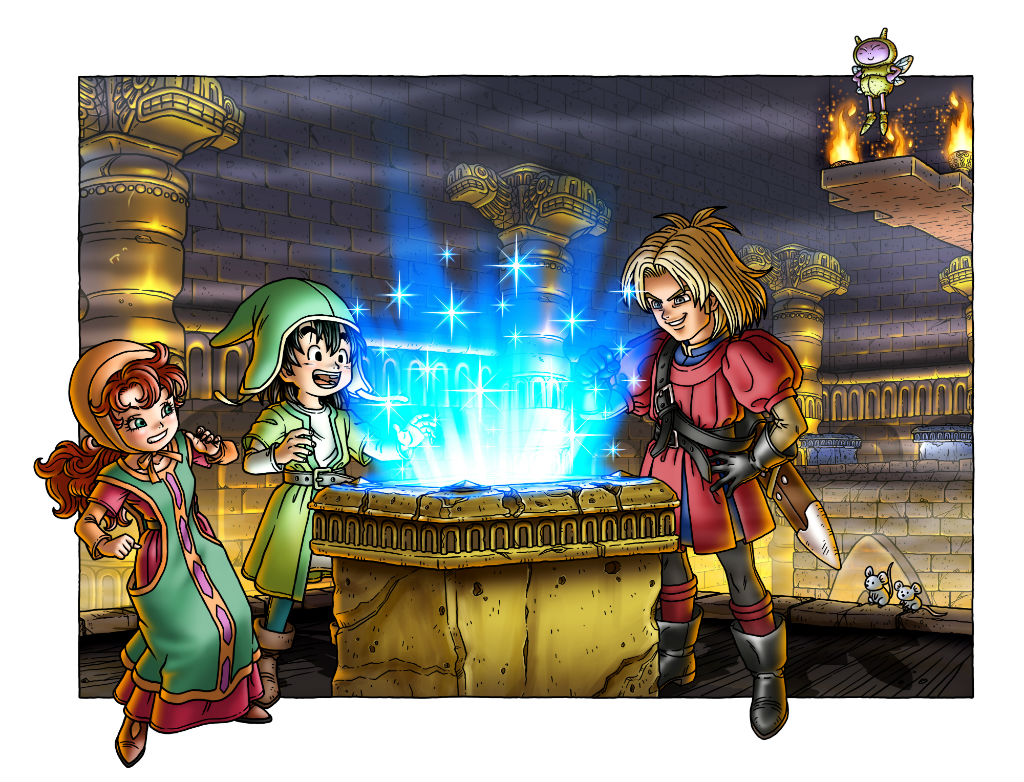
>> An epic-scale JRPG returns on 3DS with refreshed graphics and welcome enhancements
Square Enix’s timeless role-playing game classic Dragon Quest VII is back in a marvelous new remastered version, rebuilt from the ground up specifically for Nintendo 3DS. Made for fans of the original, and to introduce a whole new generation of gamers to this beloved adventure, Dragon Quest VII: Fragments of the Forgotten Past carefully preserves the original game’s charm while updating the graphics, the script, and many other notable aspects. Take a journey to the past and restore long forgotten lands in this epic coming of age story about a heroic boy and his band of faithful friends.
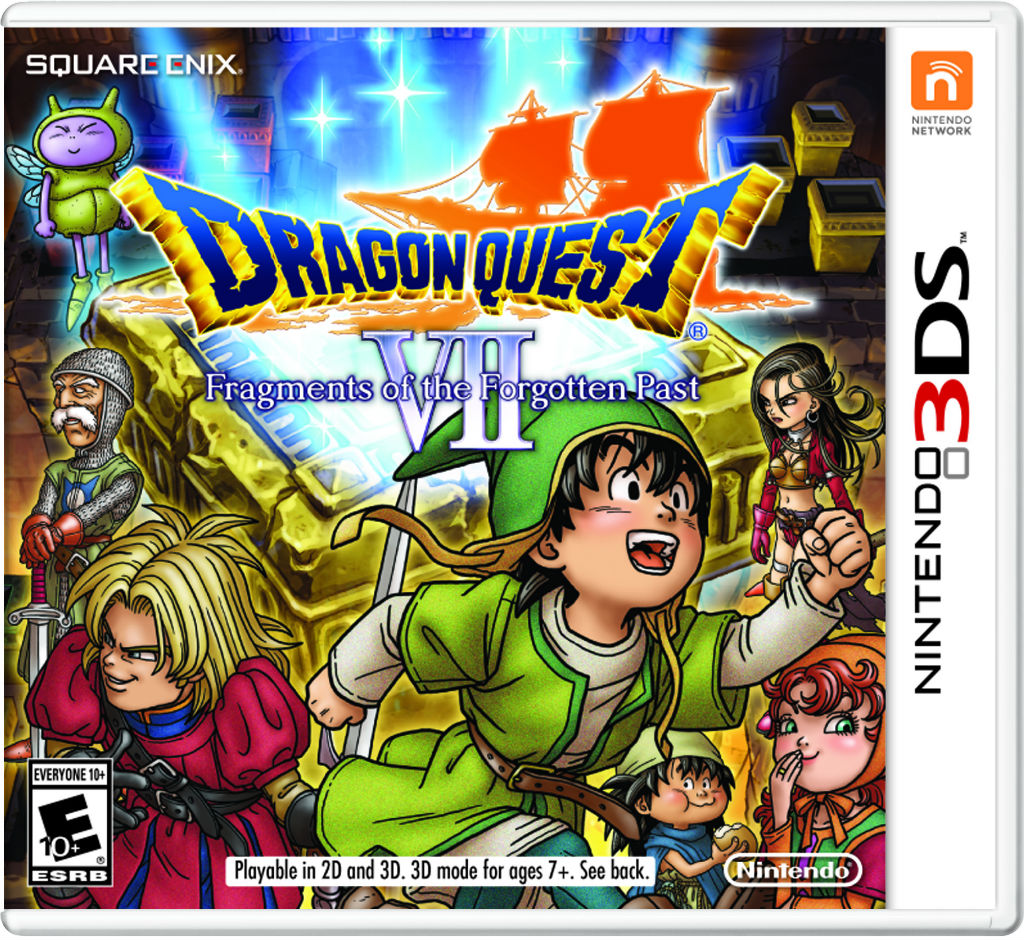 Fans’ wish granted
Fans’ wish granted
Fragments of the Forgotten Past took a special path to reach our shores here, and it’s worth recapping to explain just how badly fans wanted to see the game localized for western audiences. During the Nintendo Treehouse E3 2016 livestream of the game, a Square Enix rep said that due to it being extremely text-heavy, the company initially didn’t have plans to bring the game westward. However, fan outpouring, in form of emails and letters, prompted Square Enix to reconsider their decision in light of such strong demand.
Not only did Square Enix wind up making the choice to release the game outside Japan, they went one step further and completely rewrote the script for this massive 100-hour+ adventure (despite the game already having an English translation from the 2001 PlayStation version.) That, perhaps, explains why Fragments of the Forgotten Past—which released in Japan in 2013—took three full years to arrive here.
 Platform(s): Nintendo 3DS
Platform(s): Nintendo 3DS
Release Date: September 16, 2016
Developer: ArtePiazza / Square Enix
Publisher: Nintendo
Genre: Role-playing
Modes: Single-player
ESRB Rating: E10+ (Everyone 10+)
A gargantuan tale
DQVII, originally known as Dragon Warrior VII when it came out on PlayStation, was notorious for one thing, in particular: it’s huge, 100+ hour adventure. It’s amazing that Square Enix was able to pack all this content—and add even more—into a tiny Nintendo 3DS cartridge, but they did, and the results are one of the largest RPGs to ever grace the handheld console. Veteran DQVII players could conceivably finish the main story in 80-90 hours, but newcomers, and those who enjoy fully exploring their RPGs, should expect to easily go over the triple digit mark.
Don’t think that DQVII’s massive time investment means the game plods along either; mostly, every hour is just as enjoyable as the last, all the way to its satisfying conclusion. The main reason for this, I find, is how the game is structured: each area you visit along the journey is essentially a self-contained episode, introducing you to new characters, with unique problems for you to solve. DQVII also quite brilliantly flips the script by tasking you with restoring a long lost world, one island at a time, instead of the usual RPG norm of exploring a large map, one town/dungeon at a time.
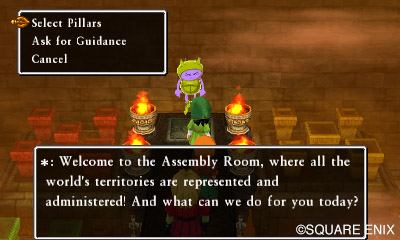 Piecing the world back together
Piecing the world back together
DQVII’s grand tale has humble beginnings in Pilchard Bay, a quaint port town on the southern coast of the Island of Estard. You play the role of Auster, a young fisherman’s boy expected to carry on his family’s business, though we quickly discover he has a much more adventurous goal in mind. Together with his best bud Prince Kiefer, heir to the Estard throne, and Maribel, the headstrong daughter of Pilchard Bay’s mayor, the three investigate a nearby shrine in hopes of dispelling the myth that Estard is the only land that exists in the entire world. For as long as everyone can remember, the island has always been surrounded by an endless ocean.
 In the shrine, the trio encounters a strange fairy curator who tells them that in order to reveal the truth about their world, they must collect coloured tablet fragments scattered far and wide. As it turns out, the fragments are like puzzle pieces, and when assembled correctly they open portals to past, forgotten lands. Through each time warp the team encounters fascinating, strange civilizations from long-ago, and must help them overcome dire problems—usually in the form of a powerful monster lurking nearby.
In the shrine, the trio encounters a strange fairy curator who tells them that in order to reveal the truth about their world, they must collect coloured tablet fragments scattered far and wide. As it turns out, the fragments are like puzzle pieces, and when assembled correctly they open portals to past, forgotten lands. Through each time warp the team encounters fascinating, strange civilizations from long-ago, and must help them overcome dire problems—usually in the form of a powerful monster lurking nearby.
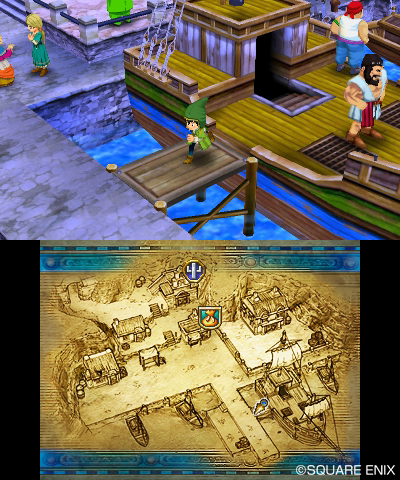 Livelier towns in stunning 3D
Livelier towns in stunning 3D
Like in past Dragon Quest remakes, many of towns and characters you’ll encounter throughout the adventure have had their names altered—but that’s just the tip of iceberg as far as what’s been changed. The most apparent improvement, and it’s a huge one, is the completely redrawn graphics by acclaimed manga artist Akira Toriyama, including all-new 3D character models. While everything has been given a gorgeous fresh coat of paint, I’m also really impressed with how faithful the new artwork is the original; most town objects are in the exact same spot as the original, right down to the location of bookshelves or trinkets hanging on the walls. The beautiful soundtrack by Koichi Sugiyama has been remastered as well, and the newer tracks are just as charming and inviting as you might remember from the original.
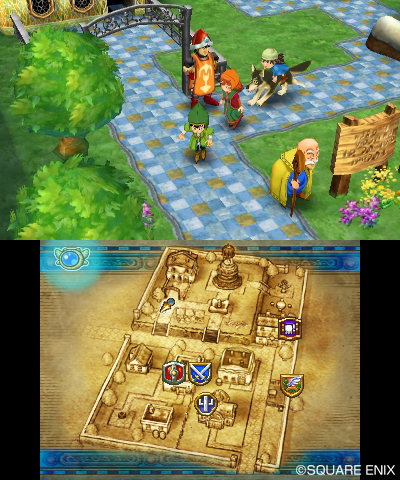
The reworked script comes into play in a big way while in towns, too. Each town now has its own distinct culture, rituals, and dialect (mostly modeled after real-world languages like German, Spanish, Italian, and Irish), and the citizen’s feel even warmer and personable this time around, making their desires and dilemmas that much more relatable. Once you finally solve the town’s central crisis, you’ll be whisked back to Estard where the island will suddenly reappear in present day, and you can take a boat (or later, magic carpet) to pay it another visit. Perhaps the most gratifying moments in DQVII come when you discover towns have aged centuries since you last stepped foot in them—with nobody realizing their island had, in fact, disappeared—giving you a strong sense of righting wrongs as you gradually restore the entire world. Reinforcing this accomplishment is how citizens will reminisce about a “legendary hero” that saved them, which of course you know is you.
My sole criticism regarding the refreshed towns is how few character models Square Enix bothered to make, meaning that you’ll see the exact same NPCs in practically every new area you visit. This becomes particularly noticeable the odd time an NPC perishes, only to see the exact same character model in the next town—or when you travel back to the present, revisit a town, and see the exact same character seemingly still alive hundreds of years later. In many ways, DQVII cleverly modernizes or masks its oldschool RPG roots, however there are still instances like these that remind you this is a remastered version of a 15 year old game.
 Traditional turn-based battles
Traditional turn-based battles
DQVII’s battle system remains largely unchanged from the original, presenting you with traditional turn-based combat from a first-person perspective. Your party of up to four characters can strike with normal attacks, spells (consume MP), and skills (some use MP), and for ease-of-use you can issue orders for your party members (or control them directly.) While I never really found battles to be very difficult—bosses included—the sheer artistry and charm of virtually all enemies you encounter keeps battles fun and pleasing. From all the ridiculously cute slime variants (Healslimes will melt any heart), to hilariously named foes like “Deathcargot,” “Meowgician,” and “Forky Pig,” (who are exceptionally well-designed too, I might add), I never once found myself getting tired of battles, even dozens and dozens of hours in.
 As testament to just how large of an adventure DQVII is, its central character class system doesn’t rear its head until nearly 20 hours into your journey. With another 80 hours of story to go, you’ll still have a long, long time to experiment with it, though. There are over 30 different vocations (more than any other DQ title) to assign your party members, with classes grouped into Basic, Advanced, Master, and Monster types. Basic vocations are fun—if not familiar—to RPG regulars, including staples like Warrior, Priest, Thief, Martial Artist, Mage, and more. Once you’ve mastered a few basic jobs, your characters can unlock more advanced roles, such as the Gladiator that requires knowledge of Warrior and Martial Artist skills. Monster Vocations are my favourite though, as these allow you to become a monster, including fan-favourites like Slimes and Walking Corpses, and use its unique skills. Your character will even look like the monster in battles and when walking around the overhead map, a neat touch you can’t help but smile at.
As testament to just how large of an adventure DQVII is, its central character class system doesn’t rear its head until nearly 20 hours into your journey. With another 80 hours of story to go, you’ll still have a long, long time to experiment with it, though. There are over 30 different vocations (more than any other DQ title) to assign your party members, with classes grouped into Basic, Advanced, Master, and Monster types. Basic vocations are fun—if not familiar—to RPG regulars, including staples like Warrior, Priest, Thief, Martial Artist, Mage, and more. Once you’ve mastered a few basic jobs, your characters can unlock more advanced roles, such as the Gladiator that requires knowledge of Warrior and Martial Artist skills. Monster Vocations are my favourite though, as these allow you to become a monster, including fan-favourites like Slimes and Walking Corpses, and use its unique skills. Your character will even look like the monster in battles and when walking around the overhead map, a neat touch you can’t help but smile at.
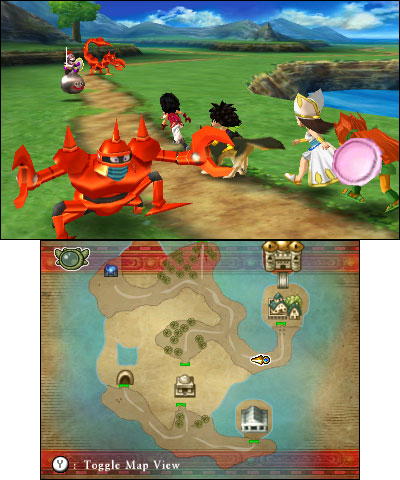 3DS features
3DS features
Along with the redone graphics and script come more welcome changes that enhance the 3DS version. For starters, an all-new “Fragment Detector” found on the console’s lower touch screen will pulsate more quickly the closer you come to locating a tablet fragment. This simple addition helps to keep the story moving along at a brisk pace, instead of forcing you to turn over every stone in search of elusive fragments that would otherwise be very well-hidden. DQVII also includes a handy “Story Summary,” accessible at any time in the menu, which will recap current events to get you quickly caught up to speed. As someone who often revisits games days, or weeks later depending on my schedule, this feature easily allowed me to jump right back to where I left off with a full understanding of what my next objective is.
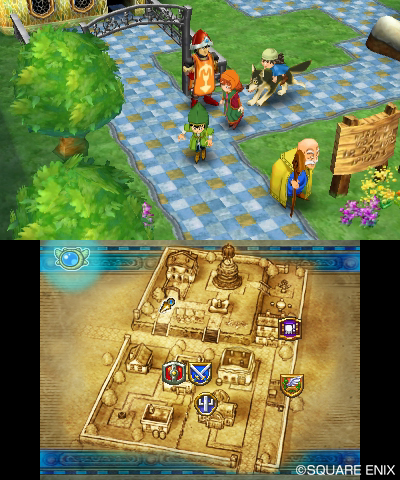 On the field, enemies are now visible (versus random encounters in the original), letting you decide when to fight or flee, and giving you a moment to heal up should you choose to engage. I also like how enemies roam the map using specific patterns and mannerisms, with some creatures walking slower and less observant, while others are fast and aggressive. This change helps better define monsters, which is nice to see, as it gives us further insight into their personalities. StreetPass, one of the core features of Nintendo 3DS, wasn’t forgotten as well, but in an odd choice StreetPass doesn’t come into play until nearly 20 hours in (just like the vocation system). Using StreetPass, you’ll be able to exchange “Traveler’s Tablets” with other players that unlock special dungeons containing hard to find items and rewards. This content is on top of the 100+ hour main quest, extending the life of the huge game to an almost obscene degree.
On the field, enemies are now visible (versus random encounters in the original), letting you decide when to fight or flee, and giving you a moment to heal up should you choose to engage. I also like how enemies roam the map using specific patterns and mannerisms, with some creatures walking slower and less observant, while others are fast and aggressive. This change helps better define monsters, which is nice to see, as it gives us further insight into their personalities. StreetPass, one of the core features of Nintendo 3DS, wasn’t forgotten as well, but in an odd choice StreetPass doesn’t come into play until nearly 20 hours in (just like the vocation system). Using StreetPass, you’ll be able to exchange “Traveler’s Tablets” with other players that unlock special dungeons containing hard to find items and rewards. This content is on top of the 100+ hour main quest, extending the life of the huge game to an almost obscene degree.
The only real downside, I found, with the game’s enhanced graphics is the perceptible pop-in that occurs when wandering the field, especially egregious when what appears to be a flat plains turns out to be a dense forest once you get a little bit closer. I was also a bit dismayed at the lack of support for the new Nintendo 3DS right nub, which you cannot use to adjust the camera. Instead, you’re left to use the shoulder buttons to move the camera, and even after dozens of hours I still found it be a bit cumbersome. With that said, these are small gripes in an otherwise stellar game that absolutely belongs in the library of every Nintendo 3DS fan of RPGs.
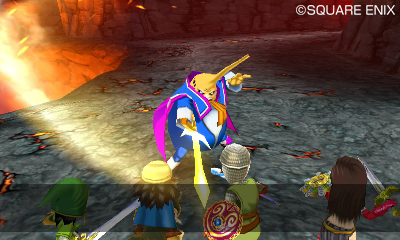 Final Thoughts
Final Thoughts
Dragon Quest VII: Fragments of the Forgotten Past is a phenomenal remake with inspired changes that make this classic JRPG even more enjoyable to play. No matter if you’re a fan of the original, or have been thinking of trying the Dragon Quest series for the very first time, this is a 3DS game no RPG gamer should miss out on. From a pure content perspective, you could easily be playing this game until mid-next year, or beyond, and still be experiencing new parts. I love the all-new graphics, and appreciate the wonderful script changes, which combine modernize the game and make it that much more accessible. This is one of the best RPGs to ever grace the Nintendo 3DS, and considering the console’s exceptional selection of RPGs already available, that’s saying a lot.
+ Wonderful and inviting story
+ Beautiful characters and environments
+ Great 3DS feature additions
+ Superb localization
+ Near endless amount of content
– Too many reused NPC character models
– Camera is awkward
– Noticeable graphical pop-in
OVERALL
Gameplay: 4/5
Graphics: 4.5/5
Sound: 4.5/5
Lasting Appeal/Replayability: 5/5
Overall Rating: 4.5/5 (90%)
Get Dragon Quest VII: Fragments of the Forgotten Past for Nintendo 3DS




Having played a few Dragon Quest games in the past, I am looking forward to giving this game a try. I have always liked the style of Dragon Quest games, and from the images and video I have seen of this game it appears to live up to my expectations. I also much prefer the traditional JRPG style to the new western RPGs that we often receive.
Comments are closed.